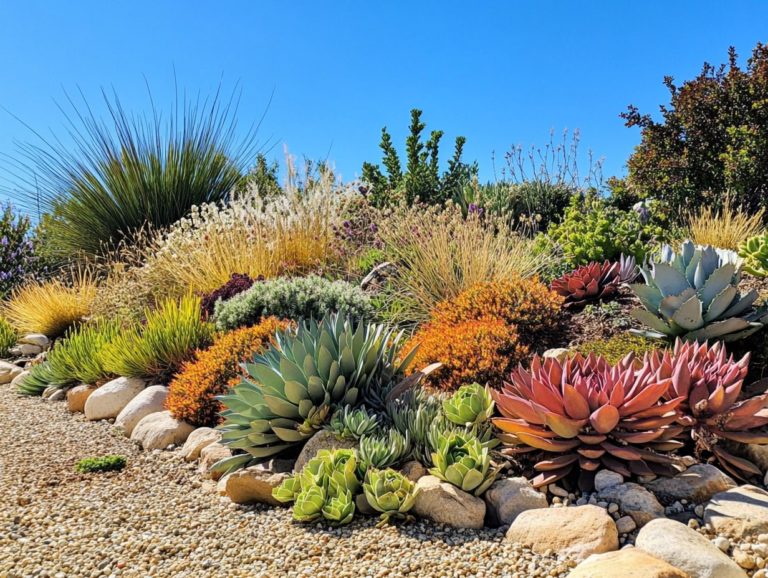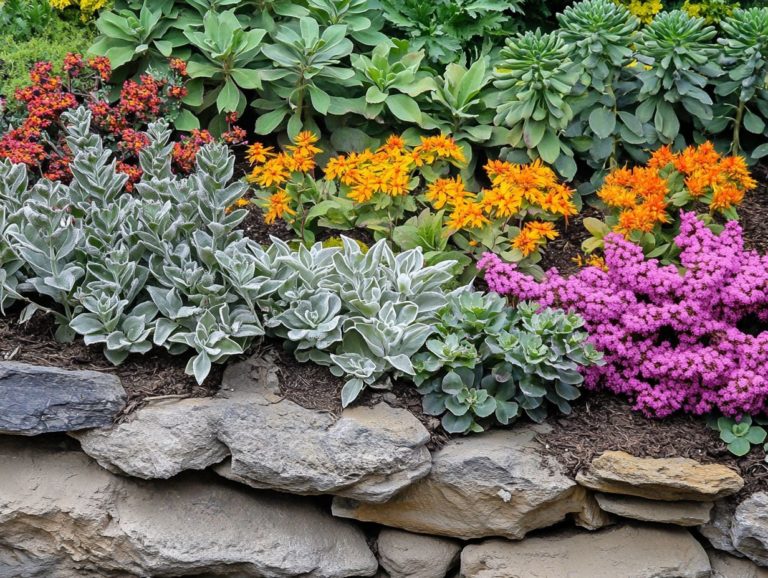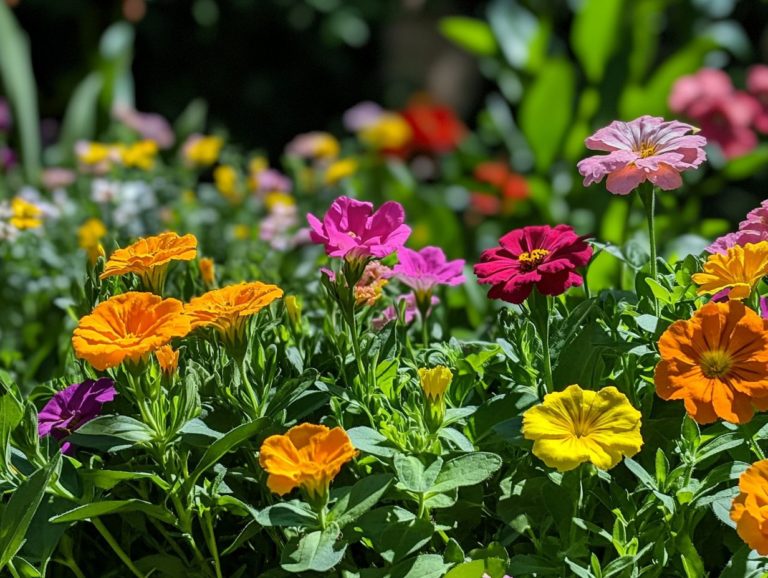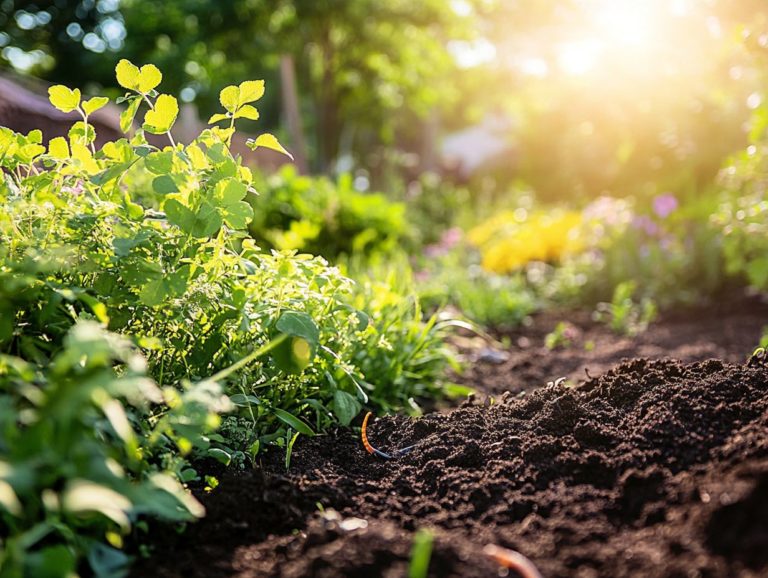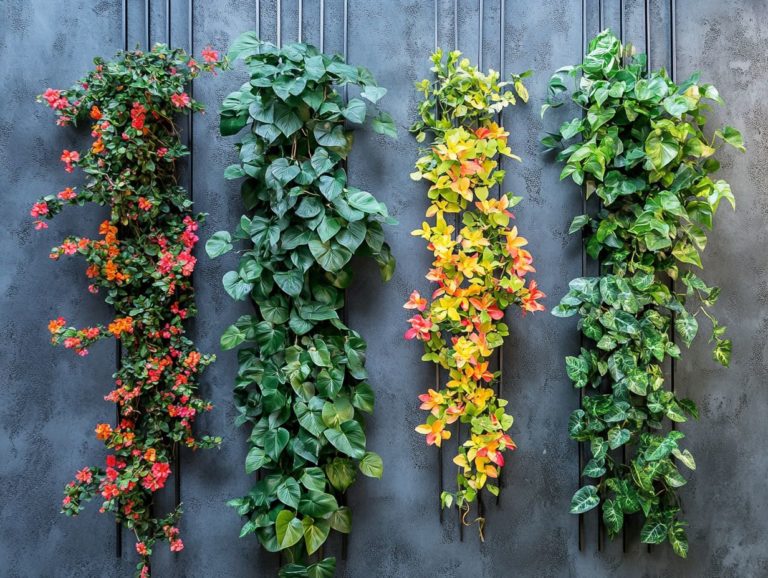“How to Choose Companion Plants for Your Garden”
Companion planting is a time-honored gardening technique that can transform your garden into a flourishing ecosystem. By thoughtfully pairing plants, you can enhance growth, deter pests, and elevate overall health.
In this article, you ll uncover the many benefits of companion planting and key factors to consider when selecting the ideal partners for your plants. You ll also discover the best combinations for popular vegetables like tomatoes and zucchini.
Whether you re tending to a container garden or cultivating a sprawling vegetable patch, you ll learn effective strategies to maximize your garden’s potential.
Contents
- Key Takeaways:
- The Importance of Companion Planting
- Factors to Consider When Choosing Companion Plants
- Best Companion Plants for Common Garden Vegetables
- Companion Planting Strategies for Different Garden Types
- Frequently Asked Questions
- What are companion plants?
- Why is it important to choose companion plants for your garden?
- How do I know which plants are good companions?
- Can I mix vegetables and flowers in my companion planting?
- Are there any plants that should not be planted together?
- Is it possible to change companion plant combinations each season?
Key Takeaways:

- Companion plants provide numerous benefits to your garden, such as improved soil quality and pest control.
- When choosing companion plants, consider factors like soil and sunlight requirements, compatibility, and pest and disease control.
- Some recommended companion plants for common vegetables include marigolds for tomatoes and radishes for zucchini.
The Importance of Companion Planting
Companion planting is an essential technique for boosting plant growth by strategically pairing compatible species. This leads to healthier crops and maximizes your available space.
Embracing this method enhances plant vitality while helping to control pests and diseases, making it a sustainable choice for both novice and seasoned gardeners. By recognizing the significance of companion planting, you can cultivate a flourishing garden that thrives on the natural interactions between plants, yielding impressive results for your gardening endeavors.
You can achieve all this while keeping in mind privacy regulations and guidelines set by entities like Google LLC and Amazon.com.
Benefits for Your Garden
The benefits of companion planting are truly remarkable, offering you a powerful way to boost plant health and productivity while managing pests naturally.
Get ready to boost your growth rates! Combining marigolds with tomatoes creates a protective barrier against small pests that harm plants, all thanks to the natural compounds released by marigolds. Planting basil alongside peppers not only improves flavor and yield but also attracts beneficial insects like pollinators.
Such thoughtful plant pairings increase variety in your garden, fostering a more resilient ecosystem that thrives without relying on chemical interventions.
Factors to Consider When Choosing Companion Plants
When choosing companion plants for your garden, it s essential to consider several factors. Look at soil requirements, sunlight exposure, and plant compatibility to create a harmonious growing environment that aligns with your gardening goals.
This thoughtful approach fosters healthy plants and enhances the overall aesthetic and functionality of your garden space.
Soil and Sunlight Requirements
Understanding the soil and sunlight needs of your companion plants is crucial for crafting a thriving garden ecosystem that promotes health and productivity.
Each soil type sandy, clay, or loamy has characteristics that affect plant growth. For instance, loamy soil’s richness in organic matter offers excellent drainage and fertility, making it ideal for vibrant vegetables like tomatoes and peppers. Conversely, clay soil, while nutrient-rich, can become too dense for some plants to flourish.
Adjusting pH levels can also be transformative. Azaleas thrive in acidic soil, while lavender prefers slightly alkaline conditions. Sunlight exposure whether full, partial, or shade plays a crucial role in your plants’ success. Sun-loving varieties, like sunflowers, bask joyfully in bright light, while ferns find comfort in cool shade beneath taller plants.
Understanding these elements can significantly elevate your gardening efforts.
Start experimenting with companion planting today, and see immediate improvements in your garden!
Plant Compatibility
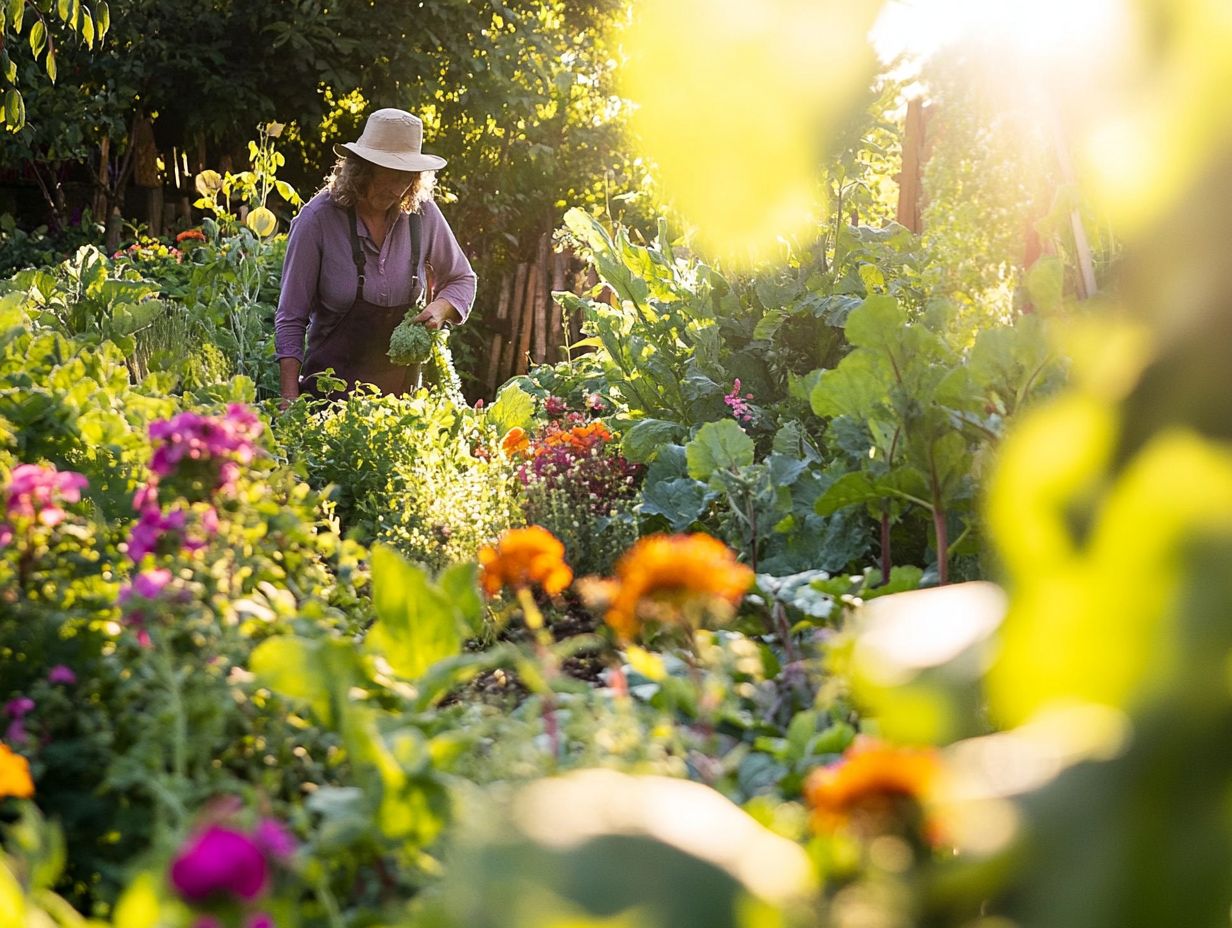
Plant compatibility is essential in companion planting. Certain plants can genuinely enhance each other’s growth and bolster resilience against pests, fostering a harmonious ecosystem in your garden.
To evaluate plant compatibility, identify shared traits such as growth habits, nutrient needs, and pest resistance. For example, tomatoes and basil thrive together. The aromatic basil leaves help deter pesky aphids and whiteflies that often target tomatoes.
Additionally, marigolds can act as a natural pest deterrent when planted near your vegetables. Their robust scent effectively repels nematodes, tiny worms that harm plant roots.
By recognizing these mutual benefits, you cultivate a thriving garden environment and boost your yields by thoughtfully selecting plants that flourish together.
Pest and Disease Control
Effective pest and disease control is one of the most significant advantages of companion planting. Pairing certain plants can repel harmful insects and reduce the spread of diseases in your garden.
When you strategically combine specific species, you create a natural ecosystem that enhances plant vitality. Take marigolds, for example; their scent deters nematodes and aphids, making them great companions for tomatoes and peppers.
Garlic also serves as a formidable repellent, keeping a range of pests at bay when planted alongside roses.
Basil enhances the flavor of nearby plants and fends off whiteflies and aphids, contributing to a healthier garden overall. These natural allies cultivate resilience in your plants, allowing them to flourish while minimizing the need for chemical interventions (substances that harm pests but can also affect beneficial insects).
Best Companion Plants for Common Garden Vegetables
Selecting the ideal companion plants for popular garden vegetables such as tomatoes, zucchini, carrots, and lettuce greatly elevates your garden’s productivity and bolsters pest resistance. This approach nurtures a thriving garden ecosystem and promotes overall plant health.
Tomatoes
Tomatoes thrive remarkably through companion planting. Certain plants enhance their growth and offer natural pest control.
By pairing your tomatoes with beneficial plants like basil, marigold, and garlic, you cultivate an ecosystem that boosts the health of these cherished fruits.
For example, basil not only elevates the flavor of your tomatoes but also repels pesky aphids and flies. Marigolds, with their striking blooms, release compounds that fend off nematodes and other garden nuisances.
Garlic complements this dynamic relationship beautifully. It produces sulfur compounds that act as a natural deterrent against aphids, spider mites, and whiteflies.
This blend of companion plants enhances your garden management and pest control efforts, ensuring a robust and bountiful tomato harvest.
Zucchini
Zucchini flourishes when paired with compatible companion plants that encourage healthy growth and keep pests at bay.
For instance, planting marigolds alongside your zucchini can significantly boost your garden’s health by repelling nematodes and various harmful insects.
Basil not only enhances the flavor of your zucchini dishes but also attracts beneficial pollinators, making it a win-win for your kitchen and garden.
Corn is another stellar companion; it offers natural support for zucchini’s sprawling vines while providing shade that helps conserve moisture.
By incorporating these plants, you create a harmonious ecosystem in your garden, optimizing nutrient uptake and fostering robust plant development. Get ready for a zucchini harvest that will impress your friends and family!
Carrots
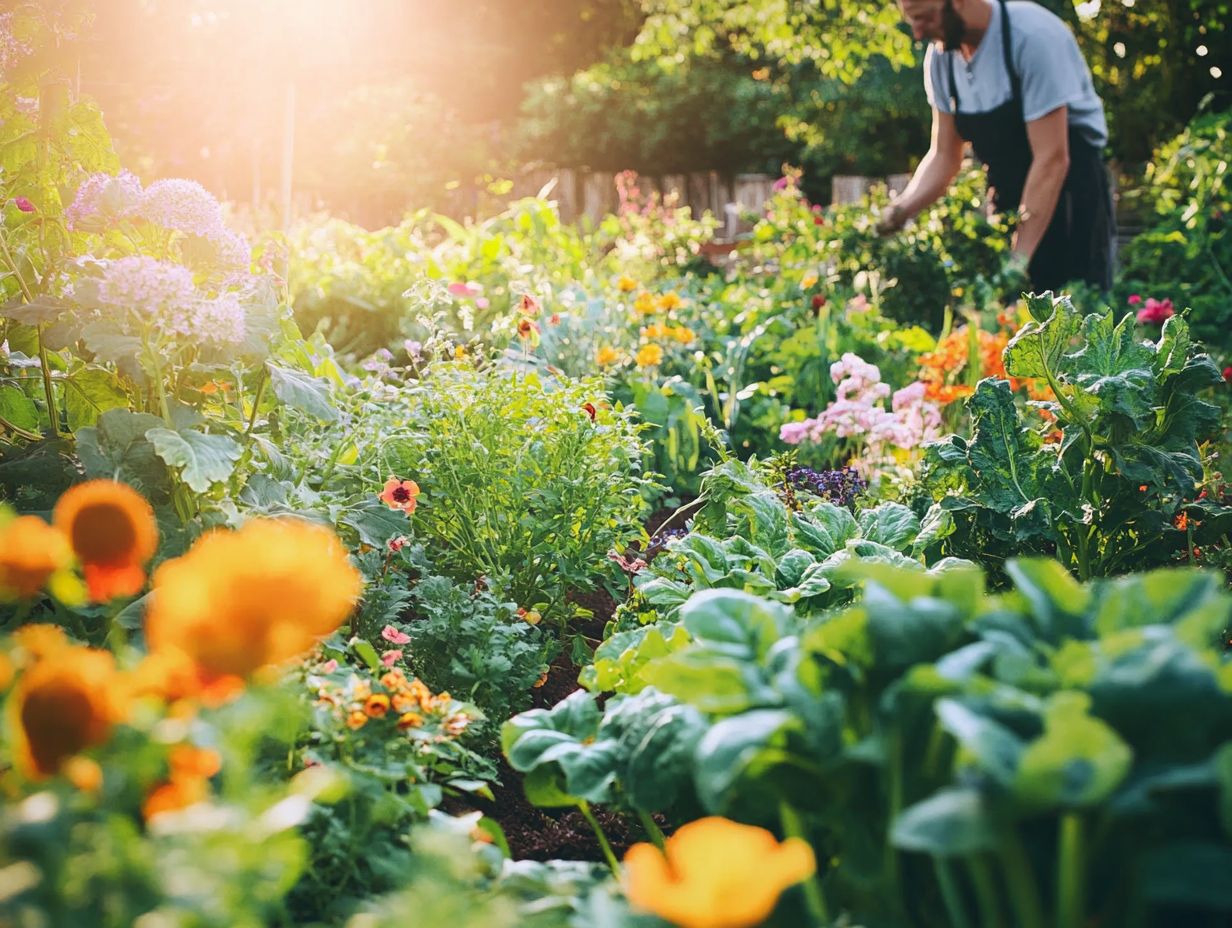
Carrots gain significantly from companion planting. Certain plants enhance their growth and provide natural pest management.
Select companion plants to cultivate a thriving ecosystem that promotes healthier root development and effectively deters harmful pests. For example, pairing carrots with onions maximizes your garden space and helps repel carrot flies that threaten their growth.
Growing marigolds nearby attracts beneficial insects that keep aphid populations in check. Incorporating plants that add nutrients to the soil like peas enriches the soil, benefiting your root crops.
These connections show how plants work together, illustrating how diverse gardening techniques lead to a truly bountiful harvest.
Lettuce
When you plant lettuce alongside compatible companion plants, you’ll notice improved growth rates and a reduction in pest issues. These synergies create a more favorable ecosystem, allowing your lettuce to thrive.
Incorporating aromatic herbs like basil and cilantro elevates the flavor of your dishes and helps to naturally fend off unwelcome pests such as aphids and caterpillars. Planting marigolds adds a vibrant splash of color to your garden while deterring nematodes.
Legumes like peas enrich the soil with nitrogen, fostering healthier lettuce plants. Companion planting can lead to a lush garden!
Companion Planting Strategies for Different Garden Types
Implementing effective companion planting strategies tailored to your specific garden type whether it’s a container garden, small raised bed, or expansive vegetable garden optimizes your space and resources.
This approach enhances your garden s beauty and fosters healthy plants, ensuring a thriving ecosystem.
Container Gardens
Container gardens present exceptional opportunities for companion planting. You can maximize limited space while fostering beneficial relationships among your plants.
By pairing crops like basil with tomatoes or marigolds with peppers you enhance growth and naturally ward off pests. Companion planting maximizes vertical space in tiered containers and cultivates a microclimate, or a small area with a unique climate, advantageous for both plants involved.
Integrating pest-repelling plants or nutrient-boosting companions significantly elevates your yields and plant health, transforming an ordinary balcony or patio into a thriving oasis!
Grasping the dynamics between these plants is crucial for crafting a harmonious and productive container garden.
Small Raised Beds
Utilizing companion planting techniques in your small raised beds enhances plant interactions, leading to better pest control and overall growth.
Strategically pairing compatible plants leverages their natural abilities to deter pests and encourage healthy development. For example, planting marigolds alongside tomatoes introduces vibrant color and effectively wards off nematodes and certain aphids.
Similarly, pairing herbs like basil with peppers elevates your culinary creations and helps repel flies and mosquitoes. Including legumes such as peas or beans boosts nitrogen levels in the soil, benefiting neighboring crops.
This harmonious approach promotes biodiversity and ensures your smallest garden spaces flourish with vitality.
Large Vegetable Gardens

In large vegetable gardens, employing strategic companion planting is your secret weapon for effective pest management and optimized growth across various plant species.
By thoughtfully selecting which plants to grow together, you can cultivate a thriving ecosystem that supports both health and productivity. For example, pairing aromatic herbs like basil and dill with tomatoes not only elevates their flavor but also acts as a natural deterrent against pesky pests like aphids and whiteflies.
Incorporating legumes like beans enriches the soil with nitrogen, a vital nutrient that promotes plant growth, creating a favorable environment for neighboring crops like corn and squash.
Meanwhile, introducing flowers like marigolds helps repel unwanted insects, such as aphids, while attracting beneficial pollinators to your garden. This method of working well together nurtures plant diversity, fortifying the soil and enhancing the overall resilience of your garden.
Frequently Asked Questions
What are companion plants?
Companion plants are those that grow well together and provide mutual benefits when planted in close proximity. They can help control pests, improve soil quality, and increase the overall health of your garden.
Why is it important to choose companion plants for your garden?
Choosing companion plants is important because it can promote plant growth and health, deter pests and diseases, and increase the yield and quality of your crops. It also creates a visually appealing and diverse garden!
How do I know which plants are good companions?
When choosing companion plants, consider their growth habits, nutrient needs, and pest resistance. Research and consult gardening resources to discover specific plant combinations that thrive together.
Can I mix vegetables and flowers in my companion planting?
Yes! You can mix vegetables and flowers in your companion planting. In fact, certain flowers attract beneficial insects that can improve the health of your vegetables. Just ensure the flowers share similar growing conditions and are not invasive.
Are there any plants that should not be planted together?
Yes, some plants should not be planted together as they may negatively affect each other’s growth or attract pests. For example, planting tomatoes near potatoes can increase the risk of potato blight.
Is it possible to change companion plant combinations each season?
Absolutely! Changing companion plant combinations each season helps prevent pests and diseases from building up in your garden and maintains soil health. Just be sure to research and plan to ensure successful plant growth.

